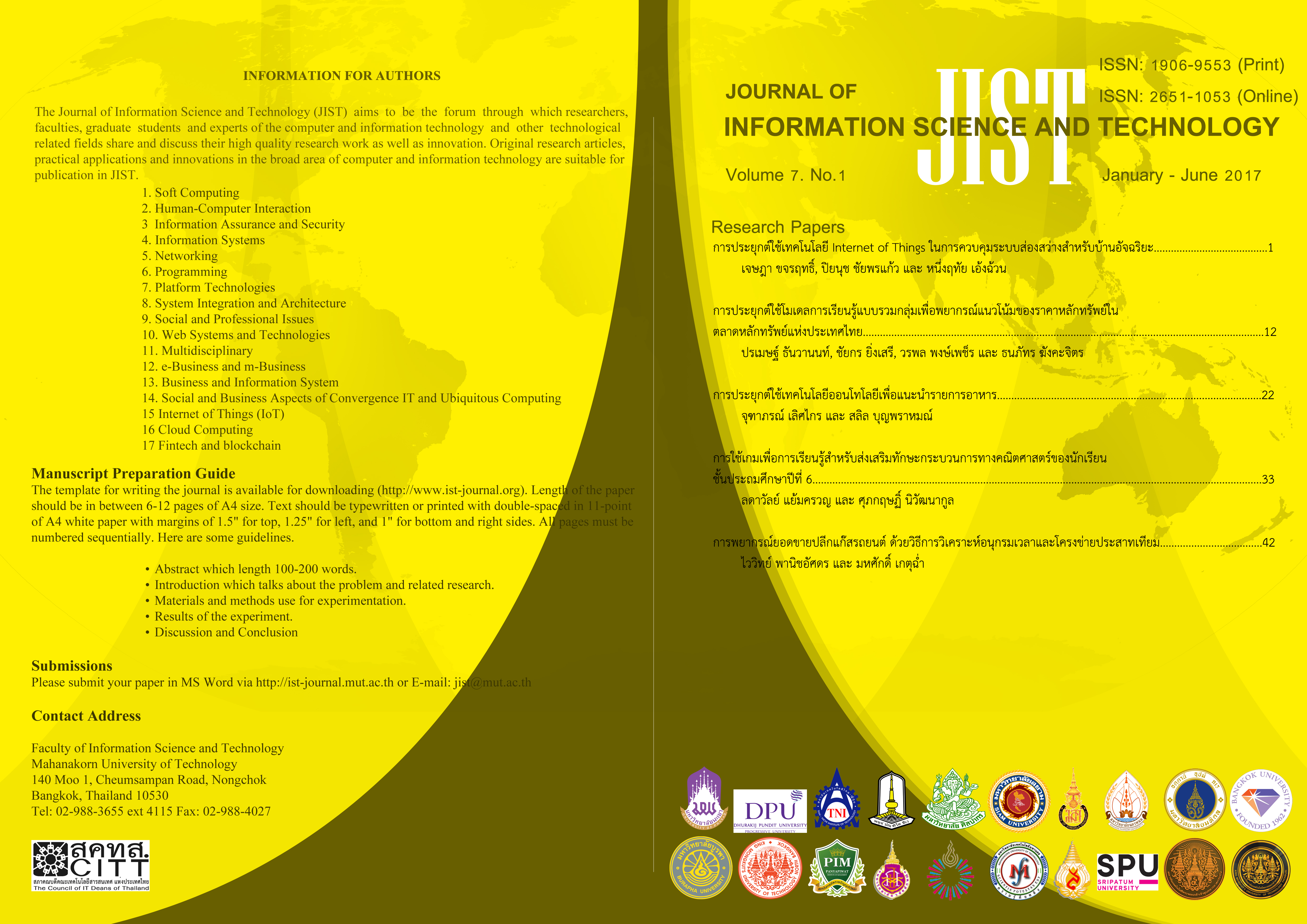การประยุกต์ใช้โมเดลการเรียนรู้แบบรวมกลุ่มเพื่อพยากรณ์แนวโน้มของราคาหลักทรัพย์ในตลาดหลักทรัพย์แห่งประเทศไทย
Main Article Content
บทคัดย่อ
- การลงทุนในตลาดหลักทรัพย์เป็นเรื่องที่น่าสนใจของเหล่านักลงทุนทั้งในและต่างประเทศ มีนักวิเคราะห์ มากมายพยายามปรับปรุงโมเดลการพยากรณ์เพื่อเพิ่มประสิทธิภาพความถูกต้องและผลตอบแทนการลงทุน แต่อย่างไรก็ตามพบว่างานวจิจัยส่วนมากจะใช้ข้อมูลราคาซื้อขายหลักทรัพย์ (stock prices data) เป็นปัจจัยหลักในการสร้างโมเดลและใช้โมเดลเชิงเดี่ยวในการวิเคราะห์ แต่ผลการพยากรณ์ดังกล่าวยังไม่มีความถูกต้องมากพอ ดังนั้นงานวิจัยนี้มีวัตถุประสงค์เพื่อเพิ่มประสิทธิภาพการพยากรณ์และผลตอบแทนการลงทุน โดยศึกษาปัจจัย 4 ปัจจัยคือ ข้อมูลราคาซืJอขายหลักทรัพย์, ข้อมูลดัชนีชี้วัดทางเทคนิค(indicators data), จำนวนวันที่ถือ(holding days) และจำนวนวันที่ใช้ในการคำนวณค่าดัชนีชี้วัดทางเทคนิค (indicator days) นอกจากนี้ได้ประยุกต์ใช้เทคนิคการวิเคราะห์การเรียนรู้ของเครื่อง (Machine Learning) 4 เทคนิค และเทคนิคการเรียนรู้แบบรวมกลุ่ม (Ensemble Model) เพื่อพยากรณ์แนวโน้มของราคาหลักทรัพย์ โดยใช้ข้อมูลของตลาดหลักทรัพย์แห่งประเทศไทยในช่วง มกราคม 2554 - ธันวาคม 2559 จากผลการวิจัยพบว่าเทคนิค Ensemble Model ด้วยวิธีการถ่วงน้ำหนักสามารถเพิ่มประสิทธิในการพยากรณ์ได้ถึง 5% - 14 % เพิ่มผลตอบแทนการลงทุน 1% - 3% นอกจากนี้ข้อมูลดัชนีชี้วัดทางเทคนิคและจำนวนวันที่ถือเป็นปัจจัยสำคัญในการเพิ่มประสิทธิภาพในการพยากรณ์และผลตอบแทนในการลงทุน
Article Details
This work is licensed under a Creative Commons Attribution-NonCommercial-NoDerivatives 4.0 International License.
I/we certify that I/we have participated sufficiently in the intellectual content, conception and design of this work or the analysis and interpretation of the data (when applicable), as well as the writing of the manuscript, to take public responsibility for it and have agreed to have my/our name listed as a contributor. I/we believe the manuscript represents valid work. Neither this manuscript nor one with substantially similar content under my/our authorship has been published or is being considered for publication elsewhere, except as described in the covering letter. I/we certify that all the data collected during the study is presented in this manuscript and no data from the study has been or will be published separately. I/we attest that, if requested by the editors, I/we will provide the data/information or will cooperate fully in obtaining and providing the data/information on which the manuscript is based, for examination by the editors or their assignees. Financial interests, direct or indirect, that exist or may be perceived to exist for individual contributors in connection with the content of this paper have been disclosed in the cover letter. Sources of outside support of the project are named in the cover letter.
I/We hereby transfer(s), assign(s), or otherwise convey(s) all copyright ownership, including any and all rights incidental thereto, exclusively to the Journal, in the event that such work is published by the Journal. The Journal shall own the work, including 1) copyright; 2) the right to grant permission to republish the article in whole or in part, with or without fee; 3) the right to produce preprints or reprints and translate into languages other than English for sale or free distribution; and 4) the right to republish the work in a collection of articles in any other mechanical or electronic format.
We give the rights to the corresponding author to make necessary changes as per the request of the journal, do the rest of the correspondence on our behalf and he/she will act as the guarantor for the manuscript on our behalf.
All persons who have made substantial contributions to the work reported in the manuscript, but who are not contributors, are named in the Acknowledgment and have given me/us their written permission to be named. If I/we do not include an Acknowledgment that means I/we have not received substantial contributions from non-contributors and no contributor has been omitted.
References
2. B. Narayanon and M. Govindarajan, ”Prediction on Stock Market using Ensemble Model”, International Journal of Computer Applications, vol. 128, no. 1, pp. 18-21, Oct 2015.
3. B.V. Dasarathy, Nearest Neighbor Pattern Classification Techniques. California: IEEE Computer Society Press, 1991.
4. G. Shakhnarovich, T. Darrel and P. Indyk, Nearest Neighbor Methods in Learning and Vision, MIT Press, 2006.
5. H. Jiawei and K. Micheline, Data Mining Concepts and Techniques, 2nd ed. USA: Morgan Kaufmann, 2006.
6. J.T. Barkoulas and C.F. Baum, “Long-term dependence in stock returns”, Economics Letter, pp.253-259, Oct. 1996.
7. L. Khaidem, S. Saha and S.R. Dey, “Predicting the direction of stock market prices using random forest”, Applied Mathematical Finance, vol. 0, no. 0, pp. 1-20, May. 2015.
8. P. Sanguansat, Machine Learning. Thailand: Panyapiwat Instutute of Management, 2015.
9. P. Sutheebanjard and W. Premchaiswadi. “Stock Exchange of Thailand Index prediction using Back Propagation Neural Network”, Second International Conference on Computer and Network Technology, pp. 377-380, Apr. 2010.
10. S. Chaigusin, C. Chirathamjaree and J. Clayden. “The Use of Nueral Networks in the Prediction of the Stcok Exchange of Thailand (SET) Index”, International Conference on Computational Intelligence for Modeling Control & Automation, pp.670-673, Dec. 2008.
11. S. Nootyaskool, M. Attasiripanya and W. Prasidtichaikul. “Stock Forecasting with Candlestick Chart and Hidden Markov Models”, National Conference on Computing and Information Technology, 2014.
12. W. Huang, Y. Nakamori and S.Y. Wang, “Forecasting stock market movement direction with support vector machine”, Computers & Operations Research, vol. 32, no.10, pp. 2513-2522, Oct. 2005.
13. W. Qiang, C. Yuehui and L. Zhen, “Ensemble model of Intelligent Paradigms for stock Market Forecasting”, Knowledge Discovery and Data Mining, pp. 205-208, Jan. 2008.
14. Z. H. Zhou, Ensemble Methods Foundations and Algorithms, New York: CRC Press, 2012.


